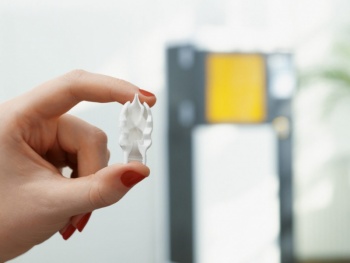
Lithoz has been commercializing the 3D printing of ceramics for 10 years. Also an AM Ventures investment and, recently, involved in a pharma production solution for vaccines, the Austrian company has a CeraFab System for manufacturing, a CeraFab Multi for multi-material printing, and the CeraFab System Medical. Now, the company has introduced the CeraFab Lab L30, a new system for laboratories and “shop floors.”
Their machine is essentially an upgraded CeraFab 7500 which is a brilliant low-cost way to make a low-cost system available. The company’s motivation for this move is to make ceramics 3D printing more widely available and to have a lower-cost entry point to their technology, “as well as a solution for fine-tuning 3D-printed parts and designs.” The system is open and can use tiny batches up to 15 ml.
The LED-based printer features 50 µm resolution and uses Lithoz’s ceramic slurry-based technology, which dips a build platform in the slurry and then illuminates it from beneath using LED. Parts are subsequently debound and sintered. Technical ceramics, such as aluminum oxide, zirconia, silicon nitride and even beta-tricalcium phosphate, are amazing, high-performance materials. But, ceramics are relatively unloved when compared to polymers and metals.
These materials offer high heat resistance, light weight, high hardness, and good compression strength, as well as wear, corrosion and chemical resistance. Ceramics keep on ticking when a lot of other materials stop working. When metals start to melt and polymers have long since caught fire, ceramics continue performing. In this sense, ceramics are a material of last resort. Sadly, for our market, many engineers also see ceramics as a material of last resort and will only use the material if they absolutely have to. With relatively little knowledge on ceramics available and with few trained on how to use them, they are mostly avoided. It’s a shame because these materials can be very beneficial for 3D printing.

For items such as end effectors, cutting tools, dies, mold tooling, any kind of wear surfaces, or for use in electrical applications or in caustic places, ceramics are ideal. They could be used much more widely in food, pharma, chemicals processing, and in machine building. In transport, they could provide us with optimized components that could significantly outperform today’s materials because they are so hard wearing and hard ceramics have been costly and difficult to machine. For new applications, such as antenna or for use in space, ceramics have a lot of exciting places to go and grow, as well.
Lithoz has done pioneering work in 3D printing ceramics and has been joined by fellow travelers, of late. Steinbach was an early customer and, through their services, many were introduced to 3D printed technical ceramics. Admatec has a very similar technology using slurries and makes investment casting shells, as well as bioabsorbable bone implants on its Admaflex systems, which use DLP and feature a modular architecture. Another similar technology is Holo AM, which is focused on using slurry-based DLP to tackle the heat sink market by making millions of copper heat sinks per year.


